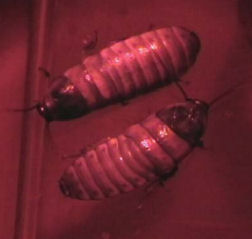Some male cockroaches whistle at females with surprisingly complex, almost birdlike sounds that vibrate through the ground and the air, researchers find.

Males of one of Madagascar’s less-studied hissing-roach species, Elliptorhina chopardi, hiss loudly at the other guys and at predators. When courting females, though, the males make soft sounds, including whistles. For the most dramatic one, each male uses two voices simultaneously, like some singing birds, Jérôme Sueur and Thierry Aubin based at the University of Paris XI–Orsay note in the October Naturwissenschaften. Under laboratory observation, males that didn’t whistle were spurned by females.
The newly recorded male roaches’ sounds are “very complex,” agrees Allen J. Moore of the University of Exeter in Penryn, England, who has analyzed airborne sounds from a different hissing roach. Hissing cockroaches are among the very few insects that communicate with a breath-powered voice as birds and mammals do, he says.
The majority of insect sounds—chirps, trills, and skritches, as well as the squeaks of other roaches—are produced by body parts rubbing together. The hissing roaches instead squirt air out of specialized holes in their abdomens. Although both male and female roaches hiss loudly at a person who picks them up, in courtship, the males are “whispering sweet nothings,” says Moore.
Sound receptors haven’t been investigated yet for E. chopardi, which are smaller than the giant hissing roaches available in pet shops. Other researchers have found that organs beneath the knee on each leg of some roach species pick up both air- and substrate-borne vibrations below 5 kilohertz. However, the most elaborate parts of the whistles reach frequencies above that range.
Sueur and Aubin’s experiment expands on work from the early 1980s that reported remarkably complicated sounds produced by E. chopardi.
Sueur focused on the quieter part of the male-roach repertoire. He put a male and female together on a piece of wood under dim red light and watched for 2 hours as the male attempted to persuade the female to mate. He recorded both sounds in the air and vibrations traveling through the wood under the roaches’ feet. Sueur says that the platform vibrations may be important if the roaches do indeed perceive them with “ears” in their legs.
Sueur’s substrate-vibration recordings are likely the first ever made for hissing roaches, says Moore.
Sueur and Aubin divided the recordings into hisses, noisy whistles with lots of staticlike fuzz, and relatively pure whistles with bands of sometimes-crisscrossing frequencies from two voices. If males didn’t give the latter whistle, they didn’t copulate, Sueur says.
Work by Margaret Nelson of Ithaca, N.Y., published in the 1980s, showed that male giant hissing cockroaches must make specific sounds to mate successfully.






